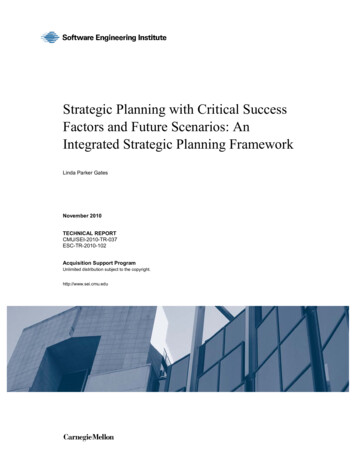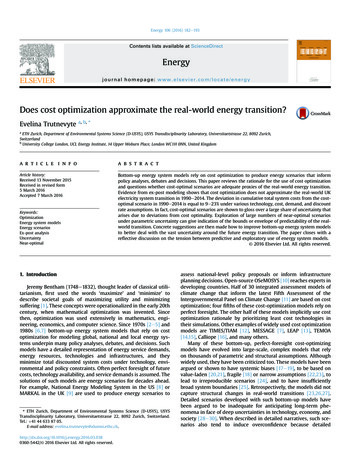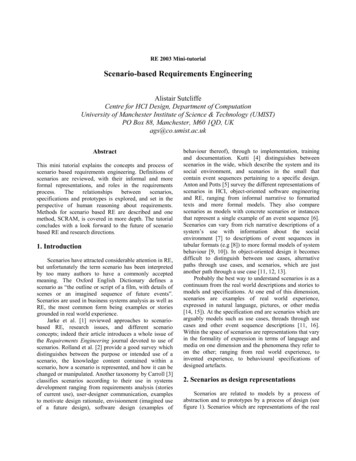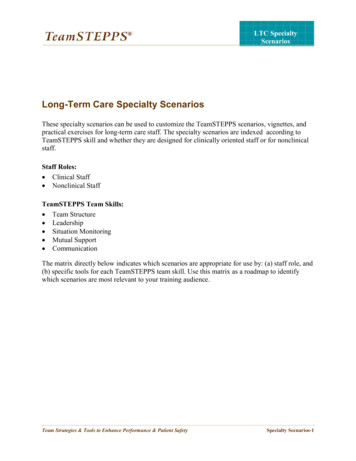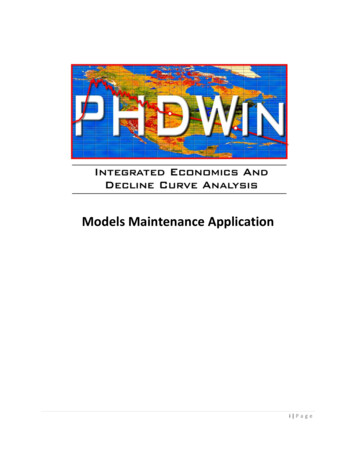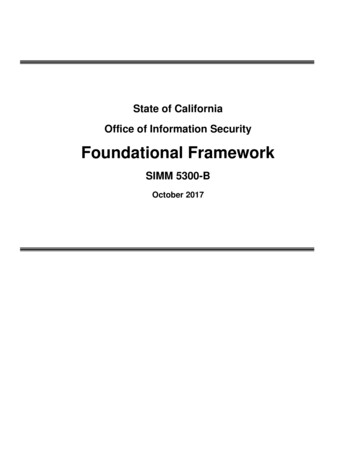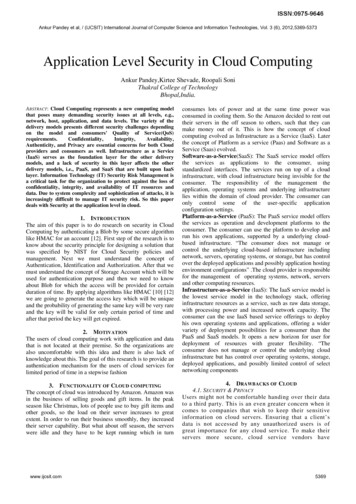
Transcription
5G Scenarios and Security DesignNovember 2016
5G5G Scenarios and Security Design4
5G Scenarios and Security DesignContentsForeword1 Overview15G Security Requirements and Challenges5G Security DesignSecurity Concerns of 5G Service Scenarios2 Security Design for eMBB Service Scenarios5Early 5G Services (VR/AR and HD Video) Are Driving the Rapid Growth of 5G Networks5G Security Supports Differentiated Services, Heterogeneous Access, and Open ApplicationEnvironmentsDesign of Key 5G Security Features3 Security Design for mMTC Service Scenarios115G Networks Provide Support for Vertical Industries Such as Smart Transportation, Smart Grid, andSmart ManufacturingmMTC Security Allows for Low-Cost, Efficient, and Ubiquitous ConnectivityDecentralized Identity Management and Authentication154 Security Design for uRLLC Service Scenarios5G Is Helping uRLLC Services (Automatic Driving, Industry 4.0) to MatureuRLLC Needs Lower Latency in Access Authentication, Transmission Protection, and Security ContextHandoveruRLLC Security Design Reduce Network Latency5 Summary: Innovative Security Design Suitable forDiverse Service Scenarios1955G
5G5G Scenarios and Security DesignForeword5G networks bring many novel technologies and advances for mobilecommunication operators. Therefore operators are able to offer a platformfor new and better services that have not been seen in the earliergenerations. Number of mobile nodes would increase rapidly becauseof developments such as Internet of Things, industrial internet and selfdriving cars. Parallel to this extension of mobile networks to new directions,traditional users of mobile devices would enjoy from improved feature sets,including better-quality video calls, augmented reality etc.Extensions to completely new types of service scenarios and new typesof devices imply that the security feature set needs major extensions aswell, compared to the earlier mobile generations such as GSM, 3G andLTE. The security architectures from earlier generations serve as a goodstarting point and a basis for 5G security. Separate security modules inthe form of SIM cards and UICCs have served mobile operators and theircustomers very well, and still continue to do so. Crucial security featuressuch as mutual authentication between users and networks, and protectionof confidential data on the radio interface are based on these modules.But this hard-core basis has to be complemented by many other securitysolutions in order to fulfill the promise of 5G networks in a secure manner.The whole 5G service palette is so wide that it is not possible to secure allof it with one-size-fits-all security solutions. Instead, flexibility is neededalso in the security domain but in such manner that all services are stilladequately protected while extra protection can be added for services thatrequire higher security. This whitepaper shows how creative solutions canbe found in all major service domains. However, further research is stillneeded to explore how all these solutions form a coherent 5G securityarchitecture.
5G Scenarios and Security DesignOverview5G Security Requirements and Challenges5G Is Expected to Meet Diverse Needs in eMBB, uRLLC, and mMTCScenarios5G is the next generation of mobile networks and seen as the enabler of the future digital world. 5G is neither a single piece of wirelessaccess technology nor simply a combination of new wireless access technologies. Rather, 5G is a truly converged network and offersseamless support for a variety of new network deployments.In order for a single physical network to meet numerous service requirements, the same underlying physical infrastructure is virtualizedinto different network topologies and functions. This means that each service type has its own network functions and these networkfunctions form a separate network slice. All network slices physically originate from the same network infrastructure, greatly reducing anoperator's investment in multi-service networks. Meanwhile, network slices are logically isolated and independent of each other, enablingdifferent service types to be separately operated and maintained.LTERAN-RTRAN-NRTCacheAC5GeMBB sliceWi-FiUPCPMobile cloud engineRAN-RTLTEuRLLC sliceRAN-NRTV2X server5GCPGWMobile cloud engineLTERAN-RT5GmMTC sliceCPRAN-NRTWi-FiRANIoT server CPUPMobile cloud engineCentral office DCSwitchLocal DCSwitchRegional DCUnified physical infrastructureDC: Data CentereMBB: enhanced Mobile BroadbandmMTC: massive Machine Type CommunicationsuRLLC: ultra-Reliable and Low-Latency Communications15G
5G5G Scenarios and Security Design5G Security Challenges and OpportunitiesService diversity is increasing (eMBB, uRLLC, and mMTC), network architecture is going to be cloud-based, and security capabilitiesare gradually opening up. All of these changes imply new security challenges and tougher privacy requirements.Various Services Have Different Security Requirements5G networks accommodate a variety of services to meet the diverse needs of individual users and industry customers. When it comesto network architecture, end-to-end (E2E) network slices on native cloud architecture have a rising prominence. Differentiated security isbecoming a top priority to 5G security designers as security requirements vary greatly with service types.Unified Security Management Across Access Technologies and Devices Is RequiredAll 5G services need common security features, such as access authentication and confidentiality protection. Despite differences amongservices, access technologies, and devices in 5G systems, a security framework with a common and essential set of security featurescan address overall security requirements.· Security management across heterogeneous accessHeterogeneous access is one of the distinct technical features of next-generation access networks. Coordination between concurrentaccess from different network systems(5G, LTE, Wi-Fi), access technologies, and site types (macro, small, and micro cells) is aneveryday phenomenon. Security management is expected to offer flexibility for all access technologies.· Security management for a large number of devicesVertical industries use a huge variety of Internet of Things (IoT) devices. Compared with traditional devices, IoT devices are larger innumber and a large number of IoT devices have burst access behavior. A more efficient method of access authentication should betailored for IoT devices. Meanwhile how to deal with mass IoT devices applying (D) DoS attacks to the network is an important issue.Comparing to a single UE, (D) DoS attacks are more damaging when massive IoT devices attacks a single network node.Delivering Security Capabilities Help Industry Customers Develop ServicesOpen services present security challenges, but they also create stronger demand for security services. As the providers and operatorsof 5G infrastructure platforms, telecom operators are the best enablers for service providers and they are also the trusted businesspartners for industry customers.By opening up their security capabilities, operators can develop 5G security technologies and expand their business, unleashing securitycapabilities as a major potential catalyst for industry applications.Stronger Privacy Protection Is ExpectedAs 5G service diversity increases and networks are more open, user data and private information will be transferred from closedplatforms to open platforms, raising privacy concerns. Meanwhile, privacy of individuals has attracted a lot of attention from people andgovernments around the world. There is an immediate need for enhancing user data protection, both online and offline.2
5G Scenarios and Security Design5G Security DesignCommon essential security capabilities should be built into 5G systems. This ensures that a unified security management mechanismcan be established across different access technologies and cloud network architectures to provide differentiated security features,policies, and solutions to specific scenarios.End-to-end Security ProtectionE2E Data Protection Provides Better SecurityCloud network architecture and heterogeneous access increase security environment complexity. Protecting user data E2E reducesreliance on cloud network security environments. It also avoids adverse impact on data security due to complex coordination betweendifferent network systems, access technologies, and site types. This would ultimately enhance user data security in cloud architecture.Differentiated Security ProtectionAnother benefit of E2E security protection is flexible data protection for different services. Security requirements vary greatly withinservice types. On-demand data protection for service sessions can be achieved through security policy negotiation and service-specificsecurity management.Avoid Repetitive Encryption and DecryptionWith E2E data protection, data no longer needs to be repetitively encrypted or decrypted at intermediate network nodes. Compared withhop-by-hop data protection, E2E data protection allows for fewer encryption and decryption attempts, shorter delay in data processing,and higher transmission efficiency.Unified AuthenticationUnified Authentication of Heterogeneous AccessEfficient coordination between concurrent access from different network systems, access technologies, and site types is a must for5G networks. It would be beneficial to build a common authentication mechanism, one that could manage access security of complexaccess networks in a unified manner.Support for Hybrid Authentication ProtocolsIn the face of diverse industries and complex service environments, 5G networks call for diversified identity management mechanismsand authentication modes, as well as a unified authentication framework that supports a variety of authentication protocols.Security Capabilities Open UpSecurity is one of the operator's assets. By opening up security capabilities, operators can provide security services to industrycustomers. It is beneficial that operators create an open service ecosystem on top of digital identity management and establish anenhanced security management and protection mechanism that can be seamlessly integrated into the business processes of thirdparties.35G
5G5G Scenarios and Security DesignOn-Demand Security ManagementThe 5G security framework is expected to address security requirements based on service scenarios and customer needs. Within thesecurity policy management framework, security policies are negotiated based on service scenarios and then applied to correspondingnetwork slices and nodes. This gives great flexibility in meeting the security requirements of different services.Security Concerns of 5G Service ScenariosInternational Telecommunication Union(ITU) classifies 5G mobile network services into:· enhanced Mobile BroadbandeMBB refers specifically to bandwidth-intensive services, such as high-definition video, virtual/augmented reality (VR/AR). Theemergence of eMBB enables digital life.· massive Machine Type CommunicationsmMTC is suitable in scenarios with dense connectivity, such as smart transportation, smart grid, and smart manufacturing. With the helpof mMTC, a digital society is taking shape.· ultra-Reliable and Low Latency CommunicationsuRLLC is a collection of ultra latency-sensitive services, such as automatic/assisted driving and remote control. The advent of uRLLCpaints a bright future for the digital industry.The following chapters explain how 5G security design can address the security requirements of these service types.4
5G Scenarios and Security DesignSecurity Design for eMBB Service ScenariosEarly 5G Services (VR/AR and HD Video) Are Driving the RapidGrowth of 5G NetworksWith the rapid growth of mobile broadband Internet and the widespread use of smart devices, almost 50% of an operator's networktraffic comes from mobile video services. This figure will continue to increase. An immersive VR/AR service, that is accessible ondemand, is becoming a primary eMBB scenario. Predictably, evolution from 4K/8K video to this type of immersive, on-demand mobileservice will encourage a strong demand for connectivity, as the service will become the flag bearer for early 5G services, driving 5Gnetworks forward.Key 5G security features should be explored in eMBB scenarios.5G Security Supports Differentiated Services, HeterogeneousAccess, and Open Application EnvironmentsVR/AR and HD Video Demand Differentiated Data ProtectionDifferentiated security requirements for various services should be fulfilled in eMBB network slices. The potentially large marketfor eMBB will produce various security requirements. For example, immersive and interactive VR/AR at anytime and anywhere willbecome the next-generation social platform application for individual users, and form an ecosystem with the industry application andthe enterprise application. The former may require encrypted transmission of sensitive information, while the latter may require theencrypted transmission of all location information. Also, the level of security protection varies among personal applications and publicservices, such as security surveillance.Concurrent High-speed Access from Different Network Systems, AccessTechnologies, and Site Types Raises New Security RequirementsUnified authentication of heterogeneous access and security management are critical for a reliable and fast data transmission. Futurenetworks are converged and support concurrent access from both 5G and Wi-Fi networks. If different access networks use differentauthentication mechanisms, security management could become very complex. In addition, the process of handling the security contextof UE mobility between different access technologies is slow and inefficient. Unified authentication and security context management isthe key to addressing these security challenges.55G
5G5G Scenarios and Security DesignOperators Deliver Security Capabilities to Industry CustomersSince operators are good at security management, they may improve business by sharing their security capabilities with industrycustomers. Industry customers are usually required to provide user security management and service content protection. Operatorsalready have solid security capabilities, including authentication and digital identity management capabilities. They have also won usertrust over a long period of business operations. Opening security capabilities to industry customers can achieve a win-win situation.Stronger Privacy Protection Should Be AvailableeMBB services require stricter privacy protection. Many eMBB services, such as VR/AR, deal with private information, such as userservice information, personal identities, device identifiers, and address information. The openness of heterogeneous access networksraises new privacy concerns. Moreover, with the advances in data mining technology, private information can be collected and refinedmore and more conveniently. This is done either by mining relationships between device identifiers and users or tracking users' onlinebehavior. A comprehensive privacy protection system must be in place to protect user privacy when they access eMBB services.6
5G Scenarios and Security DesignDesign of Key 5G Security FeaturesTo meet differentiated security requirements for eMBB and to support high-speed data transmission as well as the rapid growth ofindustry customers, 5G security key features should be explored in eMBB scenarios. These features include:· End-to-end security protection· Unified authentication· Security capabilities open-upService-based securitypolicy negotiationE2E security protectionService-based securitypolicy negotiationUP-GWUP-GWUP-GWLTESecurity context forheterogeneousaccess5GWi-FiOpen securitycapabilitiesAuthenticationDigital identitymanagementUnified authentication server forheterogeneous accessANCNUnified authentication of heterogeneous accessService-Oriented E2E Protection to User PlaneIt is advised to design a secure and efficient E2E data protection from user equipment (UE) to service anchors.Termination Point of E2E User Plane ProtectionE2E user plane protection starts from the UE and is terminated at egress gateways on operators' networks. Egress gateways areusually deployed in core networks. In certain scenarios where services are delay-sensitive and service servers are located in the sameregion as users, egress gateways may also be deployed on edge networks. If servers for the actual service are deployed on operators'networks, user plane protection can also be terminated at these servers. No matter whether user plane protection is terminated at corenetworks or local edge networks, it must be implemented in highly-trusted zones to ensure that service data can be securely processedand stored.Session-based E2E Protection to User PlaneSession-based E2E data protection increases security protection flexibility. The same UE may transmit different kind of session datawhen using different services. 5G security design should allow for differentiated protection to different session data transmission.Flexible Security Policy NegotiationsThe 5G E2E protection design allows for the flexible and efficient negotiation of security policies. 5G networks acquire securityrequirements from servers. Then, by matching security requirements with the security capabilities of services, networks, and devices,differentiated security protection policies are determined. For example, the security algorithm, key length, and termination point of dataprotection may vary between policies.75G
5G5G Scenarios and Security DesignProtocol Design for E2E User Plane ProtectionData from different services is transmitted in different sessions as protocol data units (PDUs). According to PDU transmission protocols,E2E user plane protection encrypts PDU payload but not headers from one end to the other. This ensures that network nodes cancorrectly understand routing information.UP-GWSecurity policycontrollerMobile cloud engineUP-GWInternetService provider1. Service security requirements2. Negotiation of E2E user-plane security policies3. Generation and distribution of E2E protection keys4. E2E protection to session 15. E2E protection to session 2Unified and Open Authentication Framework Across Different AccessTechnologies and Authentication ProtocolsOn 5G networks, a collection of access technologies will be used, including 5G, Long Term Evolution (LTE), Wi-Fi, and fixed networkaccess; some access environments are trusted and some are not. Traditionally, different access technologies use different authenticationframeworks and security context management mechanisms. The same device must be authenticated again when switching to a differentaccess technology. Co-existence of multiple authentication mechanisms increases security management complexity and delay due tothe mobility between different technologies.Unified Authentication Framework and Security ManagementA framework that supports multiple access technologies and authentication protocols should be in place to unify the handling ofauthentication and security management. This reduces security management complexity, allowing devices to share the created securitycontext when moving between different access technologies. This in turn reduces the latency in adapting security context to differentaccess technologies. In addition, operators can select different authentication protocols for different service authentication modes andexpand their reach into third-party services more easily. The Extensible Access Protocol (EAP) authentication framework is a goodchoice. It has evolved to support multiple choices of authentication protocols, such as EAP Authentication and Key Agreement (EAP-AKA)and EAP Transport Layer Security (EAP-TLS). It is recommended that the unified authentication framework be based on EAP.Sharedsecuritycontext5G base stationTrusted Wi-FiAuthentication serverUser subscriber dataUntrusted Wi-Fi8Edge server
5G Scenarios and Security DesignSecurity Context Sharing During the Handover Between Different Access TechnologiesIn the unified EAP authentication mechanism, different access technologies share the security context that is used for authentication.For example, when a device needs to switch to a different access technology, it can directly use the existing security context for fastauthentication, without needing to acquire new authentication data from the user subscriber databases. In this way, access latency isreduced.Identity Management Open-up Promotes the Development of the 5GService EcosystemOperators have established a global digital identity system based on UMTS subscriber identity modules (USIMs) and/or SIMs. Thissystem outperforms other identity management systems in terms of coverage and user base. The authentication mechanism used byoperators has been widely used and trusted. To improve user authentication reliability, most services with high security requirementsperform multi-factor authentication using short message service (SMS) verification codes.As services are increasingly converged, it is natural that 5G operators open the security capabilities based on (U)SIM and enhanceservice authentication security by introducing more authentication dimensions.Opening digital identity management and authentication capabilities to a huge variety of 5G services through application platforminterfaces (APIs) can be a win-win situation. On one hand, operators can introduce third-party services into their own platforms, thusbuilding an open ecosystem favorable to operators, enhancing user loyalty, and exploring new revenue streams. Meanwhile, third-partyservice providers can leverage operators' digital identity management capabilities to expand their service footprint.Once mutual trust has been established between service providers and operators, operators can associate digital identities with serviceinformation, allowing devices and service servers to use operators' digital identity management and network authentication capabilitiesthrough open APIs.Third-partyserviceServiceserver1. Service auth request carryingservice auth parameters2. Service authparametersDigital identityService auth parametersDevice3. Service auth Token6. Auth result4. Service authenticationDigital identitymgmt system5. Auth resultAuth server3. Serviceauth TokenNetwork95G
5G5G Scenarios and Security DesignEnhanced User Privacy Protection5G networks will extend to various industries, and more and more individual users and industry customers will use 5G networks. Userprivacy protection is becoming increasingly important. User IDs are important and private information that must be well protected,especially in open environments.A way to protect user IDs is to replace permanent IDs with random IDs, eliminating the situation in which permanent IDs have to betransmitted over air interfaces. LTE base stations are present in 5G access networks. Therefore, the protection of international mobilesubscriber identities (IMSIs) needs to be compatible with LTE authentication signaling. Otherwise, attackers may exploit the LTEsignaling to initiate downgrade attacks. Encrypting user IDs by means of asymmetric cryptographic technique can prevent attackers fromtracing or intercepting user IDs via air interfaces.Key security features explained above are not restricted to eMBB services. They are equally applicable to mMTC and uRLLC services.In the following chapters we will discuss security issues that are specific to mMTC and uRLLC.10
5G Scenarios and Security DesignSecurity Design for mMTC Service Scenarios5G Networks Provide Support for Vertical Industries Such asSmart Transportation, Smart Grid, and Smart Manufacturing5G networks must provide reliable network communication to IoT. The large number of IoT sensors emphasize the importance ofconnectivity management. For example, vehicle-to-vehicle, vehicle-to-people, vehicle-to-road, and vehicle-to-network communicationswithin Internet of Vehicles (IoV) systems are all based on hundreds of millions of sensors that, in turn, help keeping transport safe,efficient, and green. A large city may have tens of millions of smart meters that, all together, report colossal amounts of metering datato data centers every day. Smart manufacturing demands connectivity that is stable and wide-ranging. Wireless connectivity must beprovided to machines, products, and workers on-demand, linking every part of the production chain.The large number of IoT devices could make network communication rather costly for vertical industries. 5G networks must providesecure, reliable yet cost-efficient network access modes to a massive number of IoT devices.115G
5G5G Scenarios and Security DesignmMTC Security Allows for Low-Cost, Efficient, and UbiquitousConnectivityThe conventional (U)SIM-based per-user authentication mode hinders IoT growth and user base expansion due to the conflict betweenthe relatively high cost in authenticating ubiquitous IoT connectivity and the low average revenue per user (ARPU) in IoT. There is apressing need for 5G networks to reduce costs in IoT device authentication and identity management.A decentralized authentication mode could be a good choice for IoT because it can achieve: A shorter authentication chain Faster yet secure IoT access Lower authentication overheadsIn addition, it eliminates the risk of signaling storms and avoids authentication nodes from becoming a bottleneck in the authenticationprocess.Comparing to centralized authentication mechanism, decentralized authentication mechanism disperses the risk of attack in thenetwork, by avoiding a single network node attack by massive number of IoT devices, therefore reduce the risk of (D)DoS attack to theauthentication node.Some IoT devices will send service data as small data, either individually or in batches. To improve data transmission efficiency andnetwork resource utilization, asymmetric cryptographic technology can be used to simultaneously transmit small service data andidentity authentication messages.12
5G Scenarios and Security DesignDecentralized Identity Management and AuthenticationThe essence of decentralized management and authentication is to simplify online identity management, reduce complexity and removecentral authentication nodes. This will slash operators' deployment costs.Layered Design Simplifies Identity ManagementLayered yet unified management of network and service identities could help to defining a clear responsibility matrix between operatorsand industry customers as well as tailoring identity management policies to customer needs. There are many ways to implement layeredyet unified management of network and service identities: trusted credentials required for network and service access authentication canbe generated solely by operators or by operators and their customers together.Decentralized Authentication Improves Security Management EfficiencyNetwork authentication nodes should be deployed in a decentralized manner. For example, by moving them to the network edges, therewill be no need to access user identity databases at the center of networks during authentication between devices and networks.The asymmetric key management system is based on decentralization— networks do not need to store device keys or have an alwayson-line central identity management node.OperatorIndustriesKey management centerKey generation centerIndustry 1Industry customer identitymanagement centerIdentity managementserverNE identity managementcenterDeviceDeviceIndustry nnodeIdentity managementserverDeviceKey distribution (offline)DeviceAuthentication interaction (online)IBC-based Decentralized Identity Management and AuthenticationIBC stands for Identity-Based Cryptography. Unlike certificate management, IBC-based identity management uses device IDs as publickeys, eliminating the need to send credentials at the time of authentication and thus improving transmission efficiency. IBC identitymanagement can be easily associated with network or application IDs, giving flexibility in customizing or modifying identity managementpolicies.135G
5G5G Scenarios and Security DesignIBC authentication could reduce message length and numbers of interaction in the authentication process. This means that securitycapabilities can be efficiently provided to 5G mMTC services.Messages are frequently broadcast within IoV networks. To filter out non-legitimate information between vehicles, all broadcastmessages carry identity information and need to be authenticated. IoV has limitation on the length of broadcast messages in order tosave scarce air-interface resources. If messages are long or authentication interactions are frequent, packet fragmentation will occur,increasing message broadcast delay. To address this challenge, each vehicle-mounted device could have an IBC identity and relatedkey. Messages that will be broadcast to these devices are authenticated using the IBC identities. This eliminates the need to sendauthentication credentials, reducing message length and delay.KMSV2X applicationserverIBC-AuthSubscriptiondatabaseIoV eMBBeV2VV2Xapplication
5G Scenarios and Security DesignSecurity Design for uRLLC Service Scenarios5G Is Helping uRLLC Services (Automatic Driving, Industry 4.0)to MatureUltra-low latency is key to the wide use of autonomous driving, industrial control, and other ultra latency-sensitive services. E2E 5Glatency can be reduced to 1 ms under ideal conditions. In most cases, it remains between 1 ms and 10 ms. On 4G networks, E2Elatency is usually between 50 ms and 100 ms, about one order of magnitude higher than E2E 5G latency.uRLLC refers to ultra lat
The 5G security framework is expected to address security requirements based on service scenarios and customer needs. Within the security policy management framework, security policies are negotiated based on service scenarios and then applied to corresponding network slices and nodes.
